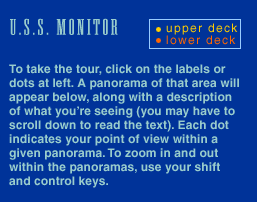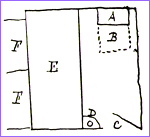
|

|

|

|
|
Intro
|
Galley
|
Deck
|
Canopy
|
Wardroom
|
Officer's Cabin
|
Captain's Cabin
|
Captain's Stateroom
|
Turret
|
Pilothouse
|
Chain Locker
|
Berth Deck
|
Engine Room - Forward
|
Engine Room - Aft Officer's Cabin To the outboard sides of the wardroom lay berthing for eight officers. These small cubicles offered modest comforts, to say the least. The four cabins lining the wardroom were six feet long by four feet wide; the other four were almost twice as wide, but the rising sides of the hull ate up the added width. Fortunately for history, the Monitor's paymaster, William Keeler, wrote long letters to his wife Anna that not only chronicle the famous battle (see Eyewitness to the Battle), but also give precise details on the ship and its equipment and furnishings. In one such letter, Keeler describes his cabin (shown in this panorama) in exacting detail and even provides a sketch: In this letter, Keeler neglected to mention that his and all the other cabins, like the wardroom, had a deck light. It was not the traditional deck prism that refracted light down into the vessel but rather a thick porthole mounted in the overhead. On deck, these portholes bore thick iron covers that one could remove to allow sunlight below; one could also open the portholes to bring in fresh air. Owing to the Monitor's shallow draft, water tended to fill the deck lights on rougher days, so each had a petcock for draining accumulated water. Tour the Monitor | Behind the Scenes Eyewitness to the Battle | Steam Machine | Resources Transcript | Site Map | Lincoln's Secret Weapon Home Previous Sites | Adventures | Join Us/E-mail | TV/Web Schedule Teachers | Site Map | Search | Shop | To print PBS Online | NOVA Online | WGBH © | Updated October 2000 |
||
 ...A is my desk, B is the door let down to write on, the
iron chest [safe] is placed underneath, C is the door, D
is the shelf in which is my washbowl, underneath is
another shelf in which are holes cut (remember that at sea
nothing is placed on a shelf, but in it) for
my slop jar, tumbler, water pitcher, soap dish &c
&c, all of nice white ware with 'Monitor' on each in
gilt letters. Over the wash bowl is a small shelf for hair
brush, comb &c. Over this shelf, & the bottom
resting on it & reaching nearly to the top of my room,
is a large looking glass in a gilt frame. The floor of my
room is covered with oil cloth on which is a tapestry rug
& on this again is a fine, soft goat's hair mat. E is
my berth, wide enough to be comfortable, & just so
long that when my head touches one end, my feet touch the
other. In front of it is a handsome rail, 8 or 9 inches
high, turning down on hinges when I wish, the top of the
rail being about on a level with my chin, so I have
something of a climb to get into bed. F.F. are two
closets, 3 shelves each, back of the berth, but they are
so high up & so far back that it is unhandy to get at
them. Under the berth are four drawers. The berth,
drawers, & closets are all of black-walnut, the
curtains are lace and damask, or an imitation I suppose.
For a seat I have a camp stool covered with a piece of
tapestry carpet.
...A is my desk, B is the door let down to write on, the
iron chest [safe] is placed underneath, C is the door, D
is the shelf in which is my washbowl, underneath is
another shelf in which are holes cut (remember that at sea
nothing is placed on a shelf, but in it) for
my slop jar, tumbler, water pitcher, soap dish &c
&c, all of nice white ware with 'Monitor' on each in
gilt letters. Over the wash bowl is a small shelf for hair
brush, comb &c. Over this shelf, & the bottom
resting on it & reaching nearly to the top of my room,
is a large looking glass in a gilt frame. The floor of my
room is covered with oil cloth on which is a tapestry rug
& on this again is a fine, soft goat's hair mat. E is
my berth, wide enough to be comfortable, & just so
long that when my head touches one end, my feet touch the
other. In front of it is a handsome rail, 8 or 9 inches
high, turning down on hinges when I wish, the top of the
rail being about on a level with my chin, so I have
something of a climb to get into bed. F.F. are two
closets, 3 shelves each, back of the berth, but they are
so high up & so far back that it is unhandy to get at
them. Under the berth are four drawers. The berth,
drawers, & closets are all of black-walnut, the
curtains are lace and damask, or an imitation I suppose.
For a seat I have a camp stool covered with a piece of
tapestry carpet.